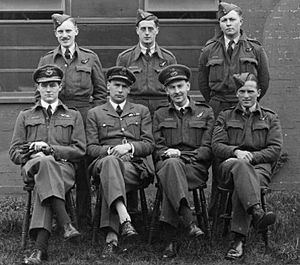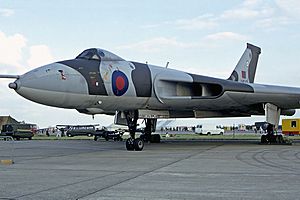No. 44 Squadron RAF facts for kids
Quick facts for kids No. 44 (Rhodesia) Squadron RAF |
|
|---|---|

No. 44 Sqn Avro Lancaster B.I in flight, 29 September 1942
|
|
| Active | 24 July 1917 – 1 April 1918 (RFC) 1 April 1918 – 31 December 1919 (RAF) 8 March 1937 – 16 July 1957 10 August 1960 – 21 December 1982 |
| Country | |
| Branch | |
| Motto(s) | Latin: Fulmina regis iusta ("The King's thunderbolts are righteous") |
| Battle honours | Home Defence, 1917–18*; Channel & North Sea, 1939–45*; Invasion Ports, 1940*; German Ports, Baltic, 1940–45; France & Low Countries, 1940; Biscay Ports, 1940–44; Ruhr, 1940–43 & 1945*; Berlin 1940–44*; Atlantic, 1942; Normandy, 1944*; Rhine, 1940–44*; Fortress Europe, 1940–44*; France & Germany, 1944–45; Walcheren. Honours marked with an asterisk* are those emblazoned on the Squadron Standard |
| Commanders | |
| Notable commanders |
Arthur "Bomber" Harris |
| Insignia | |
| Squadron Badge | On a mount, an Elephant |
| Squadron Codes | JW (Oct 1938 – Sep 1939) KM (Sep 1939 – Jan 1951) |
Number 44 (Rhodesia) Squadron was a special aviation group in the Royal Air Force (RAF). It was active for many years, from 1917 to 1982. For most of its time, it flew large bomber planes. These planes were used to drop bombs during conflicts.
Contents
History of No. 44 Squadron
Early Years and World War I (1917–1919)
No. 44 Squadron started on July 24, 1917. Its first job was to defend Britain, especially the London Air Defence Area. The squadron was based at Hainault Farm in Essex. They were pioneers in using the Sopwith Camel plane for night fighter missions. This meant they flew at night to stop enemy aircraft. By the end of the First World War, a famous leader named Arthur Harris was in charge. He later became known as "Bomber Harris." The squadron was then closed down on December 31, 1919.
Reforming and World War II (1937–1945)
The squadron was brought back to life in March 1937. It became a bomber squadron and first used Hawker Hind planes. Later that year, they moved to RAF Waddington. They then flew Bristol Blenheims and later Handley Page Hampdens. During the Second World War, the squadron moved to different bases in Lincolnshire. These included RAF Dunholme Lodge and RAF Spilsby.

When World War II began, No. 44 Squadron was part of No. 5 Group RAF. This group was led by Arthur Harris. The squadron was one of only two that flew missions constantly throughout the entire war. Two of its commanders, Roderick Learoyd and John Nettleton, even received the Victoria Cross. This is the highest award for bravery in the British military.
In 1941, the squadron was renamed No. 44 (Rhodesia) Squadron. This was to honor the help given by the colony of Southern Rhodesia during the war. Up to 25% of the squadron's staff were from Southern Rhodesia. The squadron's badge shows an elephant. This symbol was chosen to represent the idea of strong, heavy attacks.
No. 44 Squadron received its first Avro Lancaster bomber in late 1941. They were the first squadron to use only Lancasters. Their first missions with these powerful planes were on March 3, 1942. During the war, the squadron flew many missions and suffered losses:
- They flew 2,043 missions with Handley Page Hampden planes, losing 43 of them.
- They flew 4,362 missions with Avro Lancaster planes, losing 149 in combat and 22 in crashes.
The squadron had the third highest number of casualties in all of RAF Bomber Command. In July 1945, the squadron prepared to move to the Far East. They were going to join "Tiger Force" for the war against Japan.
Cold War Operations (1946–1982)
After World War II, from 1946 to 1947, the squadron got new planes. They first flew Avro Lincolns. Then, in 1951, they switched to Boeing Washington B.1 aircraft. During the Suez Crisis, they used English Electric Canberra planes. The squadron was then closed down again on July 16, 1957.
No. 44 Squadron was reformed once more on August 10, 1960, at RAF Waddington. It became part of the RAF's "V bomber" force. This force was important for keeping the UK's nuclear weapons ready as a deterrent. The squadron first used the Avro Vulcan B.1 and then upgraded to the Vulcan B.1A in 1961. These planes carried different types of nuclear weapons.
Over time, new enemy missiles made it too risky to fly bombers high up. So, the squadron's Vulcans changed their missions. They learned to fly very low to avoid detection. This helped them get closer to targets. In January 1968, the squadron received eight Vulcan B2 aircraft. These planes carried special bombs called WE.177B laydown bombs. These bombs allowed the aircraft to stay at low altitude when releasing them, making the planes safer.
Later, the Royal Navy took over the main nuclear deterrent role. No. 44 Squadron then focused on tactical strike missions. This meant they would support ground forces in Europe. Their job was to attack enemy areas far behind the front lines. They would use regular bombs first. If needed, they could use tactical nuclear weapons.
The squadron's Vulcan B2 planes continued in this low-level role until 1982. They even saw action during the Falklands War. Finally, No. 44 Squadron was disbanded for good on December 21, 1982.
Squadron Honours and Awards
During World War II, many members of 44 Squadron received awards for their bravery. These awards included:
- One Victoria Cross given to Wing Commander J.D. Nettleton.
- Six Distinguished Service Orders.
- One Conspicuous Gallantry Medal.
- One Air Force Medal.
- One British Empire Medal.
- 151 Distinguished Flying Crosses, plus one extra bar to a DFC.
- 97 Distinguished Flying Medals.
Aircraft Used by the Squadron
Here are the different types of aircraft that No. 44 Squadron operated over its history:
- Sopwith 1½ Strutter (July 1917–Sep 1917)
- Sopwith Camel (Aug 1917–June 1919)
- Hawker Hind (Mar 1937–Dec 1937)
- Bristol Blenheim Mk.I (Dec 1937–Feb 1939)
- Avro Anson Mk.I (Feb 1939–June 1939)
- Handley Page Hampden Mk.I (Feb 1939–Dec 1941)
- Avro Lancaster Mk.I (Dec 1941–Sep 1947)
- Avro Lancaster Mk.III (Dec 1941–Sep 1947)
- Avro Lincoln B.2 (Oct 1945–May 1946; Dec 1946–Mar 1947; May 1947–Jan 1951)
- Boeing Washington B.1 (Feb 1951–Jan 1953)
- English Electric Canberra B.2 (Apr 1953–July 1957)
- Avro Vulcan B.1 (Aug 1960–Sep 1962)
- Avro Vulcan B.1A (Jan 1961–Sep 1967)
- Avro Vulcan B.2 (Sep 1966–Dec 1982)
See also
- List of Royal Air Force aircraft squadrons
- Royal Rhodesian Air Force



